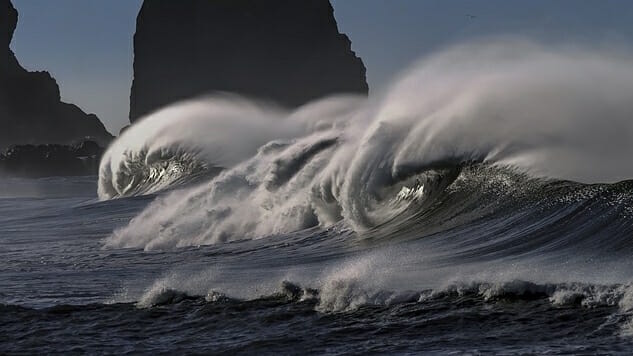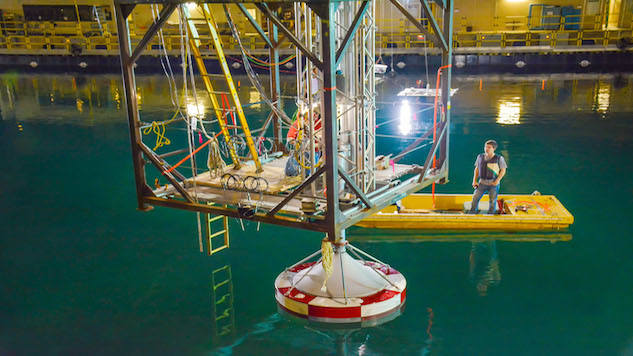Making Energy with Waves and NASA
A renewable resource on land, with a little help from space Science Features Energy
Anyone knocked down by a wave at the beach or watched a film such as The Finest Hours knows that water is a powerful force. Oceans in particular have the ability to serve as a renewable energy resource. But the very thing that makes it so appealing—its power—also makes it difficult to tap.
The simplest way to describe wave energy is what anyone can observe on a stormy day. Wind blows on water causing it to move, which creates waves. This motion, called kinetic energy (the energy an object has because of its movement) can be used to create electricity. Unlike the simple experiment of a gerbil running on a wheel to power a lightbulb, the mechanical wave energy converter (WEC) that’s necessary to transform that energy into electricity is complicated.
The payoff for the effort makes it worthwhile because more than 50 percent of the U.S. population lives along our coastlines. The “colocation of the source and the consumption” of energy make waves an ideal renewable resource, according to Giorgio Bacelli, a postdoctoral researcher with Sandia National Laboratories.
“For energy security, it’s renewable,” he says. “It’s a difficult challenge, but … society will benefit from differentiating (our) energy portfolio.”
Making Waves
European countries have been exploring wave energy since the 1970s, and the U.S. has had to play catch-up in order to participate in research and development of technological advancements. But Bacelli believes the gap is nearly closed due in part to a recent effort by the U.S. Department of Energy (DOE). The Wave Energy Prize was designed to “increase the diversity of organizations involved in WEC technology development.
Bacelli, who served as a technical advisor for the competition, says a primary goal is to reduce the cost per kilowatt hour (kwh) of wave energy. The Department of Energy’s 2015 “baseline estimate for floating, deep-water wave energy” was approximately $0.90 per kilowatt hour (kWh). By early 2017, the DOE provided an estimate of $0.66/kWh “to the Q1 Government Performance and Results Act.” The current wave energy technology development supported by the department has a stated goal of $0.17/kWh by 2030.
“Never before this project, this contest, have we seen a direct comparison on the same system, the same situation of so many different technologies,” he says. “All of these different technologies have been compared in the same scenario with the same waves and the same set up. Companies, developers, researchers are going to have access to this data to learn the pros and cons of each.”
Because the ocean environment is so harsh, engineers are experimenting with numerous types of WECs to find those that will be effective in all kind of weather and withstand saltwater corrosion. One of the most common types is a buoy, which floats on the surface of the water and tethered to the seabed. Bacelli explains that an underground cable transfers the energy created by the buoy to land.

The largest model-scale wave energy testing of its kind is being performed by Sandia National Laboratories at the Navy’s Maneuvering and Sea Keeping facility at the Carderock Division in Bethesda, Maryland. Photo courtesy of Sandia National Laboratories
Can NASA Improve the Physics?
The interaction between waves and WEC creates a system. To explain how this system works, Bacelli uses a guitar string as an example. “Resonance is a characteristic of the system,” he says. “You have a natural frequency that is the characteristic of a device. It is like the guitar string tuned to an A or a B. It’s a property (of the string)—independent of how you hit the string, it’s going to produce the same note.”
By tightening or loosening the string, the note (frequency) changes. A thicker string, such as on a bass guitar, will produce a lower note (frequency). Each WEC has its own natural frequency and so do the waves. When the WEC and the waves are in sync, the result is resonance.
“You want to change the natural frequency of the device to match the frequency of the incoming wave,” Bacelli says. “That’s what creates the resonance.
“The closer to the resonance condition, the greater the power transfer from the wave to the buoy. One way to change the natural frequency of a device is to change its moving mass by flooding chambers contained inside the device. By increasing or decreasing the amount of water moving with the device, the natural period of device changes.”
The closer the resonance condition of the device to the frequency of the waves, the higher the power transfer will be. But NASA might have a better idea.
The space agency knows a lot about resonance; rockets that send humans into space vibrate a lot. It’s Rob Berry’s job to make sure vibrating rockets won’t hurt astronauts. A NASA project manager at Marshall Space Flight Center in Huntsville, Ala., Berry says the usual method of controlling vibration is adding weight to counteract the vibration. But adding weight made the rocket too heavy, so the team developed a new technology that changed the way the rocket fuel and the rocket interact, dramatically reducing the rocket’s resonance.
Berry believes it’s possible for the same technology to help improve WEC effectiveness because it can also be used to leverage external ocean water to change the resonant condition of the buoy. Versions of this NASA technology have already been used on other solid structures, such as a skyscraper. No matter what vibration occurs—a 5.0 earthquake or 80 mile per hour wind gusts—the building won’t move dramatically. Berry says it’s “like tying a brick to a dog’s tail,” making it impossible to wag.
The same process can achieve the opposite result, greater motion. Amplification of motion allows for more energy to be harvested per wave. Preliminary analyses conducted by the DOE on an early version of the DTM indicate it could perform the way Berry predicts, but WEC testing is needed.
“We have the ability to … control the way the structure behaves in water,” Berry says. “This (new) fluid/structure coupling ability could lead to a totally different design and significantly reform what existing designs can do. There are always those innovators out there and finding those people is key.”
Berry, who refers to himself as “a rocket guy,” hopes one of those radical wave energy people will give him a call so he can pass on what he’s learned.
Top photo by RogerMosley
Margo is a science writer poking her nose into everything that piques her curiosity, from NASA and sea turtles to climate change and green tech.